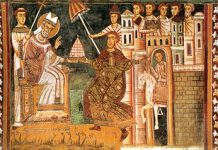In the time that my family has been on the road, our journey has been predominantly dictated by where we my parents have to work, and since they work on railroad tracks, we usually end up in railroad towns. These are mostly small towns, but sometimes we end up in places that are actually still called villages—it says so on their garbage bins.
One of the trickiest aspects of traveling through rural areas is finding a place to stay. In the west, a lot of hotels include RV hook ups among their amenities. Some towns maintain small parks with hook ups and there are countless overnight style parks along the roads. Many of these are perfectly nice parks. Others just have amazing websites. You look at the descriptions and pictures and come to the conclusion that it is a decent, if not a downright lovely place to stay for a day or two. You arrive expecting to see the place in the pictures—a park full of beautiful shade trees, long, wide RV sites, a dog walk free of nasty thorns, clean showers with boatloads of hot water, wifi, cable, and a shining laundry room.
Instead, you come to a place where a sign with an enticing name is the only thing that tells you that you really are at the place you thought you were going. The three shade trees pictured on the Internet turn out to be the only three trees in the park. The big, sprawling rv sites that were shown in the pictures are for long term residents. Overnight or short term visitors are relegated to the “easy access” spaces. These are located either right next to the nearest highway or in the farthest reaches of the park next to an ancient pile of scrap metal and wood.
The easy access sites are set so close together that to invite your next door neighbors for dinner, all you have to do is open the window and pass the food over to them. The dog run turns out to be a narrow strip of grass and weeds between the first row of RVs and the road which in any other place would be called a drainage ditch. The bathrooms reek of black mold and the shower heads are so ancient that the best you can hope for is a few drops of water at a time, but then the water goes cold. The wifi is slow, and cable consists of two channels. The laundry room has spiders and rusty machines. This perfect camping dream world is actually something of a nightmare. So you sigh and shake your head and try not to be upset by the angry handwritten signs posted on all the building doors telling you to turn off the lights when you leave.
The one thing that you do not do is keep believing that the campground is as wonderful and remarkable as it was advertised to be. At some point, probably about sixty seconds after you arrived, you became totally aware that the park either had a brilliant photographer or used ten-year-old pictures. You’ve been duped, played, etc. You might be angry enough to leave, or you might just grin and bear it and stick it out for the two days you paid for. You instantly recognize that their advertising was just false. After all, we live in a society where advertising is always painting glorious pictures that don’t resemble reality at all.
One place where false advertising is surprisingly rampant is in the abortion debate. A few days ago, I was reading an article online. The main topic was not abortion, but it was mentioned, so in the comments section a pro-lifer and a pro-choicer were ripping each other to ribbons. The two made the usual perfunctory arguments before descending into a whirlpool of ad hominem attacks. Both, in the end, made the fatal mistake that G. K. Chesterton so kindly summed up for the world. “It is not bigotry to be certain we are right; but it is bigotry to be unable to imagine how we might possibly have gone wrong.” Once a person comes to the conclusion that he or she is absolutely positively in the right on a subject, their debate ceases to rely on sensible arguments. Once reasonable argument is thrown out the window, civility is certain to follow shortly, and in a no holds barred argument, there is never a real winner.
In most battles between a pro-life advocate and an abortion supporter, the same arguments are made over and over. Each side draws up an image of the perfect world that would exist if their side could finally and definitely triumph. The abortion supporter defends an image of a world where everyone is wanted, successful, and rich. The utopia painted by pro-abortion advocates is as non-existent as the dream campground. It is full of misrepresentations and forgotten truths. Their dog walk is actually full of really nasty thorns, like women dealing with depression or medical complications after abortions or birth control pills being linked to heart attack, strokes, death, or cancer. The fact that women have become more objectified, not less, since contraception and abortion became commonplace is quietly swept into a locked room. The immense negative economic impact of abortion is not to be mentioned. The “utopia” is a sad place all dressed up in photos of wealthy (and therefore happy) families and the promise of complete freedom. Unfortunately, prolife debaters tend to draw upon equally unrealistic projections. The world does not magically become fixed the moment that abortion is outlawed. We still have the repercussions of decades of legalized murder to deal with, and the fact that we live in a fallen world will always appear to haunt us. So we have two equal and opposite stances, and an argument that neither party can win.
The argument of abortion is not really just about unborn babies. Ironically, things become more obvious when the terms zygote or fetus are used to obscure the similarities between a born and an unborn human. There the truth of the matter finally rears its head. A bunch of cells whose mother wants it and chooses it is a baby. A bunch of cells whose mother does not want it and does not choose to keep it is a zygote or a fetus. In these terms, the argument ceases to be about only abortion. According to this argument, a person’s worth is dictated by his or her value to society. If there is no value to society—if the person is not wanted—then personhood ceases. The natural end to the thought process that says a child who creates too much of a physical, mental, emotional, or financial strain can and should be destroyed is that ANYONE who poses too much of an emotional, physical, mental, or financial strain on the persons around her or to society in general should be terminated. Thus, a terminally ill patient who is loved and wanted is a person. A terminally ill patient who is not wanted is a burden. If even one life is not considered sacred, then the argument can be made that no one’s is. Abortion and euthanasia are not too different battles, but exactly the same one—two really horrible RV parks hiding behind the same façade.
We believe beyond a doubt that God exists and that if He exists, then He is all good and deserving of all our love. Love implies trust. If we profess to trust and love God, then we are bound to obey His laws, and since science has now revealed just how early life exists, the commandment against murder means that we are morally bound to defend unborn lives as well as the lives of people who are walking or crawling or lying around. But we are not called to do that in a way that dehumanizes another person, e.g. by engaging in arguments that likely have no other end but name calling and rudeness. We are not the makers of the law, but merely law abiding citizens who hopefully have enough faith to carry on no matter what gets thrown at us. Sometimes that means we have to stop arguing and say “I don’t have all the answers. I only know that I must do what the Church has declared to be right and good.” Does that make us sound foolish? Yes, absolutely. Does it mean that someone else will probably get the last word and we will be slammed and insulted? Yes, Absolutely. After all, nobody ever said that being on the side of good would be pleasant or comfortable, or come with lovely, happy photos—just that it would triumph in the end.










